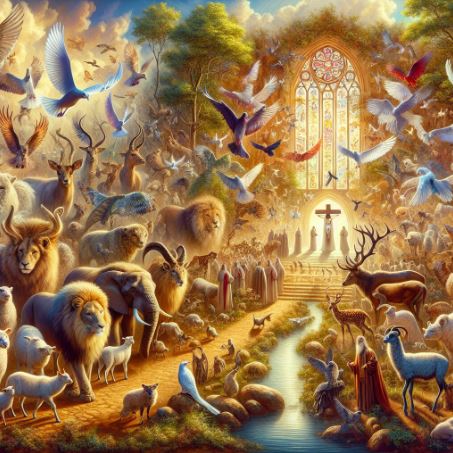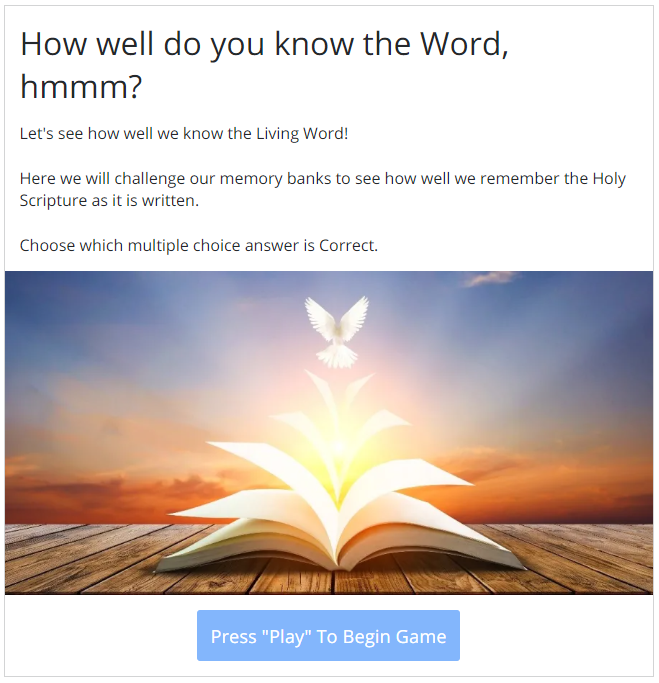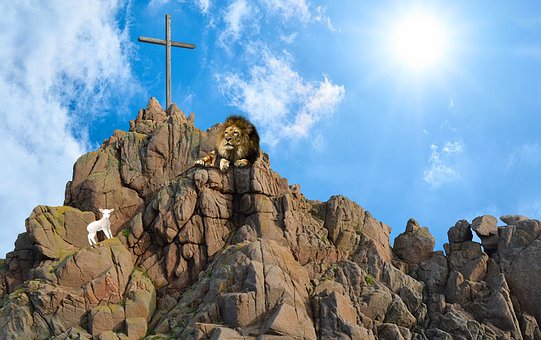We do have a certain amount of development. This does not mean that everything came from one little cell but that God made one of each creature and there has been development from each one.
God commanded the fish and fowl to be produced. This command he himself executed. Insects, which are more numerous than the birds and beasts, and as curious, seem to have been part of this day’s work.
The Creator’s wisdom and power are to be admired as much in an ant as in an elephant. The power of God’s providence preserves all things, and fruitfulness is the effect of his blessing.
Genesis 1:20-25 KJV
[20] And God said, Let the waters bring forth abundantly the moving creature that hath life, and fowl that may fly above the earth in the open firmament of heaven.
[21] And God created great whales, and every living creature that moveth, which the waters brought forth abundantly, after their kind, and every winged fowl after his kind: and God saw that it was good.
[22] And God blessed them, saying, Be fruitful, and multiply, and fill the waters in the seas, and let fowl multiply in the earth.
[23] And the evening and the morning were the fifth day.
[24] And God said, Let the earth bring forth the living creature after his kind, cattle, and creeping thing, and beast of the earth after his kind: and it was so.
[25] And God made the beast of the earth after his kind, and cattle after their kind, and every thing that creepeth upon the earth after his kind: and God saw that it was good.
Genesis 1:20
And God said, Let the waters bring forth abundantly the moving creature that hath life, and fowl that may fly above the earth in the open firmament of heaven.
The ancient person sees the world in three parts: the watery world of seas, lakes, and rivers; the habitable world of dry ground; and the above-ground world of the atmosphere.
The word “kind” does not mean species, but it means more than that. The word is phylum. Phylum is a synonym for “kind.” If you will look up that word in the dictionary, you will see that it means a direct line of descent within a group.
For instance, it would include not just one horse but every animal in the horse family. God created one like that, and there has been development from each one, tremendous development.
Also there has been devolution—that is, there has been development, then later there has been degeneration. Day five of creation begins, as the others have, with God speaking.
On this day, God speaks into existence the living animals for the watery world and the sky. As before, this is presented from an observational perspective—what the author or any reader could see.
The signs of animal life appeared in the waters and in the air. moving creature meaning, all producing young by means of eggs that are hatched after they have been laid by the parent.
Animals, both among the finny and the feathery tribes – remarkable for their rapid and massive increase.
Verses 20 through 23 describe God’s fifth day of creation, in which He creates all the creatures of the seas, as well as the birds.
This is according to the pattern of Genesis, where God used the first three days to prepare an environment, and the second three days to populate that environment.
On day one God created light, and on day four He created the sun, moon, and stars. On day two God created the sea and sky, and here, on day five, is His creation of sea and air life.
The pattern will then continue in later verses: On day three, God created dry land, and we will see the origin of land animals on day six.
God’s spoken command is to let the waters—the seas—teem or swarm with swarms of living creatures. The picture is of filling up an ocean intended to carry the abundance of God’s creation.
In a similar way, God commands the sky to be full of birds that would fly across its previously empty expanse. This is all part of a process where God’s design comes into focus.
He didn’t merely create the oceans for their own sake. The purpose of the seas was to support active, teeming life. The purpose of the empty sky was to host the countless variety of birds He would create.
Genesis 1:21
And God created great whales, and every living creature that moveth, which the waters brought forth abundantly, after their kind, and every winged fowl after his kind: and God saw that it was good.
The unpolluted and unfished waters of the ancient world teem with life. This includes water creatures of massive size, something the author (Moses) is aware of on some level.
Has he heard of great whales that have breached the surface of the ocean or washed up on a beach?
God’s creation has variety that is barely imaginable for us. After hundreds of years of study, scientists are still discovering and classifying new water creatures.
The author also acknowledges creation of the creatures of the atmospheric world, the birds. He knows that most creatures do not have the capability of flight—only those with wings.
These make up a special and wonderful category of God’s good created animals.
The author also gives another insight into the wonder and awe of the ancient person when it comes to beholding God’s created order: the reproductive capability of water creatures and birds. This is their ability to produce offspring after his/their kind.
Why does a sparrow always reproduce sparrows, not eagles sometimes?
Why does a trout always reproduce trout, not barracudas sometimes?
This is part of God’s created order as observed by the author, and it is marvelous for him. As we appreciate the enormous variety of God’s creatures, we should also understand the boundaries for variation He has built into each one.
fowl, meaning every flying thing: The word rendered “whales,” includes also sharks, crocodiles, etc..
So that from the countless shoals of small fish to the great sea monsters, from the tiny insect to the king of birds, the waters and the air were suddenly made to swarm with creatures formed to live and sport in their respective elements.
In the prior verse, God spoke the command for the empty seas to fill up with living creatures, and for the empty skies to be filled with flying birds. Now in this verse, He executes that command.
This is the blueprint for all six of the creative days of Genesis. God speaks and His words become reality. Later verses will continue the pattern of God observing His creation and calling it “good.”
The verse specifically mentions the great sea creatures or sea “monsters.” As with the sun and moon, these ancient beasts of the sea were frequently worshiped as gods by ancient cultures.
The Bible’s claim is that those creatures were merely created things, along with all the other fish and the birds. They were made by the one, true God in a day. He alone is worthy of worship.
This verse also specifies that all of these brand new creatures were made “according to their kind.” From the very beginning, God divided created life into categories: kinds of plants, kinds of fish, kinds of birds.
Built into each creature was the ability, the necessity, to reproduce their own kind.
Again, God recognizes that what He has made is good, giving His approval to the world He is building.
Genesis 1:22
And God blessed them, saying, Be fruitful, and multiply, and fill the waters in the seas, and let fowl multiply in the earth.
How many of each type of fish or bird does God create to get things started?
We don’t know, but we do see that His plan includes multiplication of these creatures. He intends that the salt waters and fresh waters be filled with appropriate creatures.
God intends that His created variety of birds multiply and spread throughout the earth. It is a tragedy when a species becomes extinct because of human behavior.
For the first time in Genesis, God gives a direct spoken blessing. Specifically, He blesses all the creatures of the seas and the birds.
His blessing is about reproduction and fertility and comes in the form of a command to these creatures: Be fruitful and multiply.
In other words, God both commands the birds and fish to multiply and blesses them with the ability to do so.
In making this statement, Genesis is declaring that God is not only the creator of life; He is the one who enables life to reproduce itself. He alone is the giver of fertility, of new generations.
That’s important for us to hear on several levels.
First, to worship any other god in hopes of being blessed with fertile crops or herds or human families is a waste of time. Only God grants that blessing.
Second, whatever our position on how and when God created, Genesis insists that He is the one who blesses all creatures with the ability to reproduce another generation of their kind. Reproduction doesn’t happen without Him.
For all of its beauty, the creation account of Genesis provides very few actual details. What’s meant to be understood, however, is profound: God and God alone is responsible for the design and existence of life.
Finally, we see in this verse that reproduction is a blessing. God grants new life as a gift and to fulfill His own purposes.
Genesis 1:23
And the evening and the morning were the fifth day.
As the day ends by marking the cycle of the evening and the morning, the sustaining earth has been stocked in its waters and its air.
This verse completes the normal blueprint for the creation days in Genesis. In each case, God speaks a command, which then becomes real, God sees what He has created, and then considers it “good.”
This verse features the typical reference to “evening and morning,” reflecting the Jewish concept of days beginning at sunset.
On this fifth day, God has created all sea creatures and all birds and blessed them with the ability to reproduce and populate water and air.
This also follows a pattern seen in Genesis chapter 1, where the six days of creation are paired between the first three and the last three. God created light on day one, and the sun and moon on day four.
He created the sky and seas on day two, and formed air and sea life on day five. This now sets the stage for day six: on day three, God created dry land. So, on the next day of creation, He will form both land animals and human beings.
DAY SIX—FERTILITY OF ANIMAL LIFE
A farther advance was made by the creation of terrestrial animals, all the various species of which are included in three classes:
(1) cattle, the herbivorous kind capable of labor or domestication.
(2) wild animals, whose ravenous natures were then kept in check, and
(3) all the various forms of creeping things — from the huge reptiles to the insignificant caterpillars.
Genesis 1:24
And God said, Let the earth bring forth the living creature after his kind, cattle, and creeping thing, and beast of the earth after his kind: and it was so.
God speaks again, on day six, to call into existence specific components of His overall created order. On this day God addresses the dry land, the earth itself.
This will be the home of God’s ultimate creation, human beings, later in this same day (Genesis 1:26–30).
There are three general categories of land animals presented. The first, cattle, is a generic term that means more than cows.
It generally refers to herded animals, and here it has the sense of domesticated livestock as distinct from wild animals (also see the distinction in Leviticus 25:7).
This may include goats and sheep, which are popular choices among cultures dependent on herding. Later in the history of Israel, it will be animals from this category that are considered ritually clean for food or sacrifice (see Leviticus 11).
The second category, the creeping thing, refers to creatures that live on the ground, including reptiles and snakes. Such animals will not be considered clean when the food laws are instituted for Israel (Leviticus 11:42).
It is also likely that the tempting serpent of a coming story (Genesis 3:1) is included in this category.
The third category, the beast of the earth, refers to wild animals. We might divide these into carnivores (example: lions), herbivores (example: gazelles), and omnivores (example: bears).
Such animals might be hunted for food, but they are not part of a nomadic herd or a located farm.
Here, on the sixth day of creation, God moves from the seas and the air to the land. He speaks the command for animals to come into existence.
More specifically, He calls for the land to produce living creatures according to their various kinds. This is a curious reference, and part of the long-running debate over what specific mechanism God might have used to create these animals, if any.
“Livestock” would include cattle and other domesticated animals. “Creeping things” is a reference to rodents, reptiles, insects, and so forth. “Beasts of the earth” are wild animals.
Once again, this conforms to the strict sequence shown in Genesis chapter 1. The first three days of creation show explicit parallels to the second three days.
On day 1, God made light; on day 4, He created the sun, moon, and stars to distribute that light.
On day 2, God separated the waters, creating the vast, empty oceans; on day 5, He filled those waters with sea creatures.
On day 3, God created the land and filled it with vegetation; now on day 6, He fills the land with animals ready to eat from those plants.
Genesis 1:25
And God made the beast of the earth after his kind, and cattle after their kind, and every thing that creepeth upon the earth after his kind: and God saw that it was good.
As with the creatures of the sea and air, the land creatures are made with the capacity to reproduce after his/their kind. Again, God finishes creating these three categories and sees His work as good.
We should notice there are many missing, undiscussed animals. These categories are quite general and not intended to be exhaustive.
What about rodents—are they creeping things?
What about insects?
What about worms?
Or, some might ask, what about dinosaurs?
The silence of the text on such matters is just that: no information. It does not imply ignorance or avoidance.
The author tells the story he wants to tell; and just as he does not divide the “stars” into planets, comets, meteors, and distant suns, he does not give more than a brief description of the creative activities of God on each of the days.
In Genesis chapter 1, God uses three days of creation to prepare the earth. On these first days He creates light, the sea and skies, and then dry land and plants.
On the second three days, He fills those environments with the sun and moon, air and sea life, and land animals.
In the previous verse, God commanded the creation of all the different kinds of animals and creeping things that would fill the land of the earth.
Now in this verse, He executes that command, creating what He decreed must be created. Interestingly, God phrases this command as “let the earth bring forth” these living creatures (Genesis 1:24).
In literal terms, this would imply the land animals being produced by the earth itself—making this phrase part of the ancient debate over how God chose to accomplish His creation.
Once again, God recognizes what He had made as good. God did not create anything that He decided was not up to His own standards. All that He made He called good.
In fact, God’s original creation of the universe, before being corrupted by sin, was completely good in every way. Nothing bad or corrupt had yet entered the world.
I hope that you have really enjoyed this post,
Please Leave All Comments in the Comment Box Below ↓













Hello Jerry,
I find it interesting that God created all these animals and creatures.
As you say it is sad when something becomes extinct from human activity. The Earth is full of life as I see it, but it is certainly diminishing with time.
But is that God’s intention?
As God giveth and God take away!
I like to think new creatures are yet to be found, as the ocean is so vast and still so much undiscovered. But as far as the lands across Earth, there are not many hiding spots left for animals. But then there is the universe of hidden things.
Kind regards
Erica
Hello Erica,
Thanks for taking the time to allow yourself to be part of this discussion.
You opinion is greatly appreciated. Please feel free to look around this website and see what other writings may be of interest to you.
Thanks again for your time.
Many Blessings,
Jerry
The creation is one of the greatest pieces of evidence for the existence of God.
Yet, many “atheists” are still not convinced and insist that everything and everyone came from one source – the Big Bang!
But if this were true, how can there be different kinds of kinds or species?
There has to be a Creator from whom everything came to be.
The order of everything that is created is truly amazing and no one with a sane mind could possibly claim evolution is the answer. The rule is, a certain species produces after its own kind.
Indeed, God created everything in the heavens and on earth in 6 days. But He did not just create them and leave them like that. God sustained each and every one of His creations and gave them abundant life — humans and animals alike.
What an amazing God we have; He’s not only the creator but also the sustainer of life.
Praise be to our God and Savior, hallelujah!
Thank you for an inspiring post.
Hello,
Thank you so much for your involvement of discussion about Day Five – Abundant Animal Life.
You are most certainly welcome for the sharing of this post and thank you for your opinion about it being an inspiring post.
To GOD Goes The Glory!
Blessings,
Jerry
The fact that God created all of these different animals and species is something that fascinates me.
It is unfortunate, as you point out, when a species becomes extinct due to the actions of humans. From what I can tell, the planet is teeming with life; but, this abundance appears to be decreasing over time.
What an incredible God we serve, who is not only the one who brought life into the world but also the one who keeps it going.
All glory and thanksgiving be to our Lord and Savior, We appreciate the thought-provoking post you shared.
Hello,
Thank you so much for your comment.
Blessings,
Jerry
I appreciate that you are trying to explain the first chapters of the Book of Genesis.
And you are correct, the word “kind” in this sentence structure is NOT talking about being nice and pleasant to someone, but is instead stating that each needs to be with their own species.
This terminology was used in the 1800s in reference to species or peoples. The term “humankind” is an excellent example.
Hello Angela Working,
I really appreciate your comment and it definitely pleases me to see how you are actually digging deep into the meaning of these references.
Thank you, and Have A Blessed Day,
Jerry
It is interesting to read your perspective on the creation story in Genesis 1.
You have highlighted the importance of God’s command and execution to create creatures in the waters and the sky. You also mentioned the idea of development from each creature, which is a topic of debate among scientists and creationists.
Your reference to the reproductive capability of water creatures and birds is indeed marvelous and fascinating, and it is essential to appreciate the enormous variety of God’s creatures while understanding the boundaries for variation that He has built into each one.
It is sad that human behavior has led to the extinction of some species.
Thank you for sharing your thoughts on this topic.
Hello Anoth,
Thank you for commenting, as well as, reiterating my perspective and reference in this study session. I agree wholeheartedly that it is sad that human behavior has led to the extinction of some species.
You are welcome for the sharing of my thoughts on this topic.
Blessings To You.